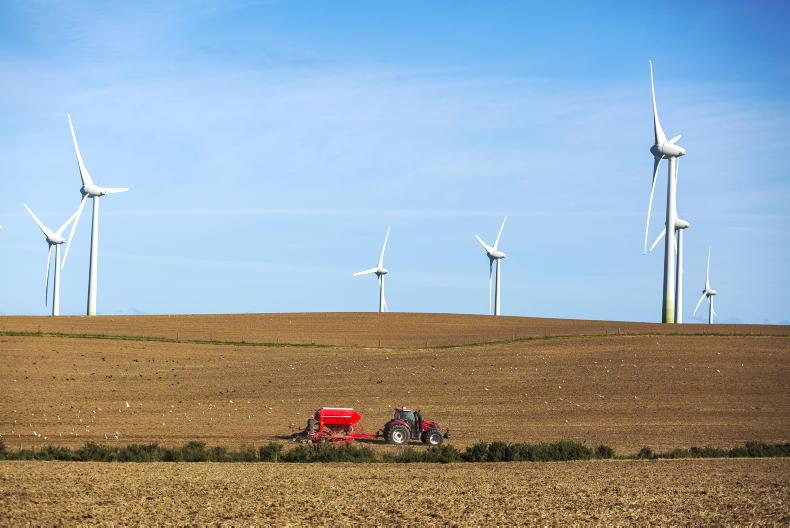Ireland’s wind electricity production has plummeted over the past two weeks as the hot, settled weather resulted in little to no wind.
The high-pressure system which is dominating Ireland’s weather and causing temperatures to soar is also resulting in lower wind generation.
Over the past two weeks, across the Irish Farmers Journal’s network of 57 weather stations, average wind speeds struggled to average above 5km/h.
Ireland’s renewable electricity production, which largely originates from wind farms has plummeted as a result.
In 2020, wind energy accounted for almost 40% of electricity used in the Republic. However, over the past week, this average figure has been closer to 12%, according to figures from EirGrid.
Demand
On 11 February of this year, Ireland broke its all-time record for wind generation at 3,591Mw.
To put it in context, current electricity demand today is peaking at around 4,000Mw.
However, generation levels have plummeted over the past two weeks.
Figure 1 shows the actual wind generation for the past 30 days, below the forecasted generation in most cases.
To compare, Figure 2 shows the wind generation for June, where peaks exceeded 2,000Mw.

Figure 1: Irish wind generation for the past 30 days (all Ireland)

Figure 2: Irish wind generation for June (all Ireland)
During multiple occasions over the past two weeks, wind generation from Ireland’s 300-strong wind farms amounted to sub-100MW and at 9.15am on 19 July, generation amounted to zero - see Figure 3.

Figure 3: Irish wind generation on 19 July
A case for diversification
Ireland’s renewable strength undoubtedly lies in its wind energy generation potential.
With offshore wind farms alone, the programme for government contains a target for 5,000Mw by 2030 and, in the long term, 30,000Mw off our western coast.
However, as this current heatwave shows, there is a strong case for diversifying our energy mix.
Solar will play a key role in this with 800Mw of solar farm projects due to be constructed this year after successfully securing funding in the first Renewable Electricity Support Scheme (RESS) auction.
However, at the time of writing this, over 50% of our electricity generation is coming from gas through a network of combine heat and power plants.
This gas can be replaced with biomethane, produced through agricultural anaerobic digestion plants once the correct market conditions materialise.
This, along with the introduction of the microgeneration scheme will ensure farmers play a key role in decarbonising our electricity mix.
Ireland’s wind electricity production has plummeted over the past two weeks as the hot, settled weather resulted in little to no wind.
The high-pressure system which is dominating Ireland’s weather and causing temperatures to soar is also resulting in lower wind generation.
Over the past two weeks, across the Irish Farmers Journal’s network of 57 weather stations, average wind speeds struggled to average above 5km/h.
Ireland’s renewable electricity production, which largely originates from wind farms has plummeted as a result.
In 2020, wind energy accounted for almost 40% of electricity used in the Republic. However, over the past week, this average figure has been closer to 12%, according to figures from EirGrid.
Demand
On 11 February of this year, Ireland broke its all-time record for wind generation at 3,591Mw.
To put it in context, current electricity demand today is peaking at around 4,000Mw.
However, generation levels have plummeted over the past two weeks.
Figure 1 shows the actual wind generation for the past 30 days, below the forecasted generation in most cases.
To compare, Figure 2 shows the wind generation for June, where peaks exceeded 2,000Mw.

Figure 1: Irish wind generation for the past 30 days (all Ireland)

Figure 2: Irish wind generation for June (all Ireland)
During multiple occasions over the past two weeks, wind generation from Ireland’s 300-strong wind farms amounted to sub-100MW and at 9.15am on 19 July, generation amounted to zero - see Figure 3.

Figure 3: Irish wind generation on 19 July
A case for diversification
Ireland’s renewable strength undoubtedly lies in its wind energy generation potential.
With offshore wind farms alone, the programme for government contains a target for 5,000Mw by 2030 and, in the long term, 30,000Mw off our western coast.
However, as this current heatwave shows, there is a strong case for diversifying our energy mix.
Solar will play a key role in this with 800Mw of solar farm projects due to be constructed this year after successfully securing funding in the first Renewable Electricity Support Scheme (RESS) auction.
However, at the time of writing this, over 50% of our electricity generation is coming from gas through a network of combine heat and power plants.
This gas can be replaced with biomethane, produced through agricultural anaerobic digestion plants once the correct market conditions materialise.
This, along with the introduction of the microgeneration scheme will ensure farmers play a key role in decarbonising our electricity mix.









 This is a subscriber-only article
This is a subscriber-only article










SHARING OPTIONS: